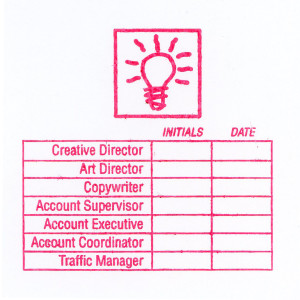The proof-stamp, that is.
Ideally, a project originates with a member of the account service team. He (or she) enters meeting notes into a Client Contact Report. This Report resides within a central information “hub” (i.e. a project management system). A job number is opened, tasks are assigned and members of the creative team work their magic.
POOF!
A “mechanical,” or hard copy, of the work is routed internally. First, the Traffic Manager is alerted and then the Creative Director carefully reviews the output.
PROOF.
Next, the Creative Director routes the mechanical to the copywriter (if applicable); he (or she), in turn, routes it to the account executive(s), and so on. All team members involved in the production of the project are ultimately asked to “initial.” This not only makes everyone involved accountable for the piece, but it further ensures accuracy.
INITIAL.
You may already have introduced an approval form, slip of paper, or even a stamp of some sort, to your team. Following is an example of the proof-stamp I used while a Traffic Manager. Each artist, copywriter, the print buyer and I had an ink pad and rubber stamp at our desk. As materials began routing, a stamp was applied to the back of the output.
Not only did the stamp’s initials tell the next person who had (or hadn’t) seen the creative and when, but it also enabled the artist(s) and I to quickly determine who had made certain proofing comments by matching the ink and handwriting style with their initials. This may seem a bit unusual, but let’s be honest. Haven’t we all asked, at one point or another, “Who wrote that?”


